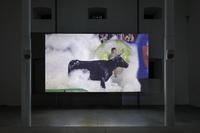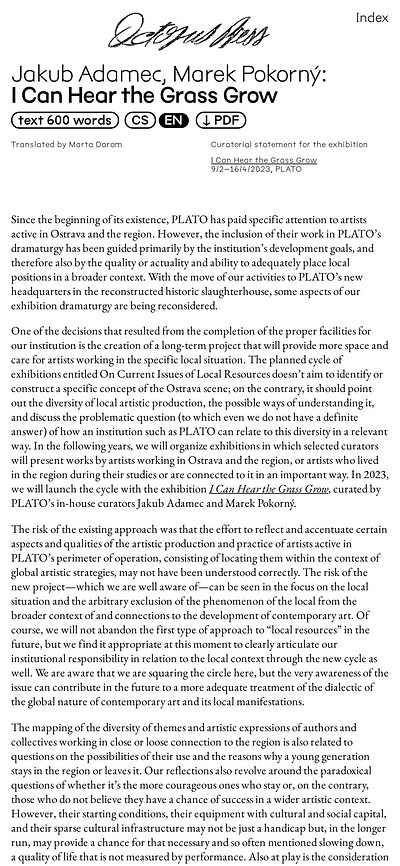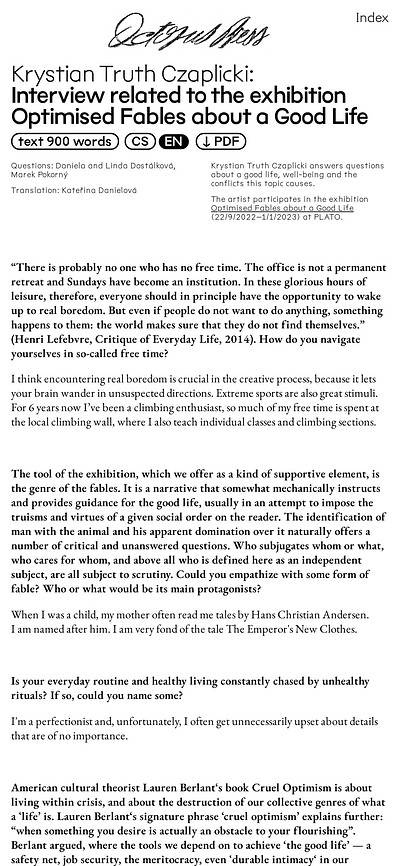Interview related to the exhibition Optimised Fables about a Good Life
Questions: Daniela and Linda Dostálková, Marek Pokorný
Translation: Kateřina Danielová
Yalda Afsah answers questions about a good life, well-being and the conflicts this topic causes.
The artist participates in the exhibition Optimised Fables about a Good Life (22/9/2022–1/1/2023) at PLATO.
The tool of the exhibition, which we offer as a kind of supportive element, is the genre of the fable. It is a narrative that somewhat mechanically instructs and provides guidance for a good life, usually in an attempt to impose the truisms and virtues of a given social order on the reader. The identification of humans with animals and their apparent domination over them naturally offers a number of critical and unanswered questions. Who subjugates whom or what, who cares for whom, and above all who is defined here as an independent subject, are all subject to scrutiny. Could you empathize with some form of fable? Who or what would be its main protagonists?
The fable as a genre is in some ways quite relevant to my work, centering around both human and animal protagonists. The bull in my film TOURNEUR, the horse in CENTAUR and the pigeons in SSRC play leading roles, and of course one could interpret them as symbols or signifiers for the larger questions that my films touch upon – the embodiment of an “untamed” nature and the critical reflection of humankind‘s attempts to cultivate and thus control it, to name one. However, for me there are some decisive distinctions between the literary genre of the fable and what I am trying to achieve within my works’ narratives: Firstly, while the fable tends to use its animal protagonists in an anthropomorphized way, as an illustrative means leading to a moral conclusion, I do not aim to present the animals as a metaphor for something else. Instead, they appear as social actors in their own right. They do act as a mirror to critically reflect on human nature or behaviour, yet they occupy their own space in my work. The second distinction lies in the question of the moral imperative itself, which is often central to the fable’s conclusion. For me, however, it feels important to leave space for the viewers to evaluate what they see. While one can definitely read a sense of judgment into my observations of cultural practices such as dressage or bullfighting, my films always also reflect on the possibility of an overarching empathy between the species, an idea that is particularly present in the intimate relationship between horse and human in CENTAUR, or in the potentially unexpected co-dependency between birds and men in SSRC. Lastly, the fable is a genre of fiction. While my work has a documentary focus, I am continuously exploring how space is cinematically constructed. It’s an important aspect during the process of editing the material to think about the element of fiction, as I navigate the interface between reality and staging – the unique and authentic dynamics I observe from behind the camera may be perceived as strange choreographies on screen; the real settings, such as the bullfighting arena filled with foam, may appear as a stage. One of my aims as an artist is to begin to dissolve such dichotomies, ultimately calling into question the clear borders between nature and culture.
In a moment when we have all indicators that the Planet is going to collapse, do you feel any conflict linked to your decisions that are intertwined with the production of artworks and environmental issues?
I reflect on this question a lot – in my case, as a filmmaker, it is mainly concerning the environmental impact of travelling for shoots. TOURNEUR and VIDOURLE were filmed in France, CENTAUR in Denmark, and SSRC in Los Angeles. Currently, I work on a new project, for which I recently travelled to Spain. For the way I work as an artist, it seems unavoidable to travel, and I have profited immensely from the experience I was able to make abroad, amongst others during my studies at Cal Arts in LA. I am very conscious of that and it’s a conflict I cannot really solve. I have started to work a lot with people on site though, for example having a local line producer has proven very helpful in terms of preparing the shoots in advance without having to be on site. And of course, doing research online and meeting people on Zoom has become normalized through the experience of the pandemic – I think there is a lesson we can take from this period.
Wellbeing seems so self-evidently good that it escapes scrutiny, enabling it to slide from useful tool to expectation; of ourselves and of others. In fact, wellbeing has taken the place of morality. Instead of working to improve the world, we work to improve ourselves. What kind of wellbeing activities of the future can you predict?
I’m not really imagining wellbeing activities as such. You’ve mentioned the collapse of the planet and environmental concerns – I think the only way towards future wellbeing is to find ways of co-existence and to give up our anthropocentric worldview, which arguably is at the core of most of our planetary problems. My focus on the “animal other” leads many to think I make films about animals – but actually, more than anything, I am observing, exposing and reflecting on human behaviours and practices. As I mentioned before, I avoid taking on a moralistic tone in my works, but I do think we need to question the “human” category itself, which was invented within the ontology of the moderns to dominate and exploit all and everything deemed “natural”, including (but not limited to) animals.
The relationship between humans and animals and the processes that formally determine and establish it is crucial to the film work of German-Iranian artist Yalda Afsah (b. 1983). The artist explores how this relationship can be constructed by means of film. At first glance, the documentary nature of her work often refers to theatrical forms. This specific practice of the artist is conceptually reflected in her documentary portraits of relationships between humans and animals, which reveal their ambivalent nature oscillating between care and control, physical strength and broken will, instinct and manipulation. Yalda Afsah seeks to question and dissolve these dichotomies while creating a space to consider the possibility of an umbrella interspecies empathy. In the subjugation of animals, anthropocentric power relations naturally manifest. Yalda Afsah studied at the Berlin University of the Arts (UdK) and the California Institute of the Arts (CalArts).
- Language
- Type
- Palate Cleanser2025
- cs
- en
text- 2,000 words
- Monika Pascoe Mikyšková: Memories that aren’t mine2025
- cs
- en
text- 500 words
- Kino Kosmos under the Cosmic Sun2025
- cs
- en
text- 9,800 words
- Kino Kosmos2025
- cs
- en
text- 3,700 words
- Dorota Jurczak: Pyk, Sciak etc.2025
- cs
- en
text- 1,500 words
- Sprouts2025
- cs
- en
text- 800 words
- Curatorial text for the exhibition by Petr Bosák, Robert Jansa and Adam Macháček2025
- cs
- en
text- 900 words
- Curatorial text for Martin Zetová's exhibition2025
- cs
- en
text- 1,100 words
- Cello & Piano2025
- cs
- en
audio - Primeval Forest, Garden and Wall2024
- cs
- en
- pl
text- 1,100 words
- Interview with Barbora Lungová2024
- cs
audio - Barbora Lungová and the gift of painting2024
- cs
- en
text- 1,400 words
- Julie in the Worlds of Fantasy. Marginalia.2024
- cs
- en
text- 1,600 words
- Pigeon newspaper2024text
- Workbook for children The Shell No. 32024
- cs
- en
text- 200 words
- Zvířecí kustodi – Bee2024
- cs
- en
video- 32’32”
- Animal Custodians – Rabbit2024
- cs
- en
video- 33’18”
- Animal Custodians – Owl2024
- cs
- en
video- 28’05”
- Animal Custodians – Fox2024
- cs
- en
video- 32’05”
- Animal Custodians – Deer2024
- cs
- en
video- 33’45”
- Animal Custodians – Pigeon2023
- cs
- en
video- 32’20”
- Animal Custodians – Raven2023
- cs
- en
video- 21’24”
- If you have a canary with a poor singing voice, it will never stop singing after this training video!2023
- cs
- en
video- 21’24”
- Checking the Stove2023
- cs
- en
video- 5’34”
- 0’40”
- Trust2023
- cs
- en
video- 7’03”
- Is it the flight or the fall what my friend is falling for?2023
- cs
- en
video- 12’08”
- Animal News2023
- cs
- en
text- 1,500 words
- Dan Walwin: Relief2023
- cs
- en
text- 1,000 words
- Ukrainian Culture at the Time of Russian Aggression2023
- cs
- en
text- 100 words
- Freely Accessible Books on the Topic of Ukrainian Culture at the Time of Russian Aggression2023
- cs
- en
text- 500 words
- They Thought We Were Alive and They Run Screaming2023
- cs
- en
text- 1,200 words
- On Renewed Land: Locating Ukrainian Destiny2023
- cs
- en
text- 1,900 words
- I Can Hear the Grass Grow2023
- cs
- en
text- 600 words
- Interview related to the exhibition Optimised Fables about a Good Life2022
- cs
- en
text- 900 words
- Interview related to the exhibition Optimised Fables about a Good Life2022
- cs
- en
text- 900 words
- Interview related to the exhibition Optimised Fables about a Good Life2022
- cs
- en
text- 700 words
- Interview related to the exhibition Optimised Fables about a Good Life2022
- cs
- en
text- 1,700 words
- Interview related to the exhibition Optimised Fables about a Good Life2022
- cs
- en
text- 1,000 words
- Interview related to the exhibition Optimised Fables about a Good Life2022
- cs
- en
text- 1,100 words
- Interview related to the exhibition Optimised Fables about a Good Life2022
- cs
- en
text- 900 words
- Interview related to the exhibition Optimised Fables about a Good Life2022
- cs
- en
text- 1,600 words
- Interview related to the exhibition Optimised Fables about a Good Life2022
- cs
- en
text- 900 words
- Interview related to the exhibition Optimised Fables about a Good Life2022
- cs
- en
text- 1,400 words
- The Night2022
- cs
text- 0 words
- Optimised Fables about a Good Life2022
- cs
- en
text- 800 words
- In the footsteps of the Greek underground II: Longing for deep time2022
- cs
- en
text- 7,200 words
- In the footsteps of the Greek underground I2022
- cs
- en
text- 12,800 words
- Elective Affinities: “Anarchism Without Adjectives”. On the Work of Christopher D’Arcangelo 1975–1979 with Dean Inkster and Pierre Bal-Blanc2022
- cs
- en
video- 58’01”
- Curatorial Control2022
- cs
- en
text- 2,500 words
- Ruins. Reconstruction of the past and construction of the future2022video
- 1h 14’43”
- Long Evening with Octopus Press2022
- cs
audio - Oh and Hah, Beauty, Ruin and Slack2021
- cs
- en
text- 900 words
- Our Living Ruins2021
- cs
- en
- pl
text- 3,100 words
- Troubling Time/s and Ecologies of Nothingness: Re-turning, Re-membering, and Facing the Incalculable2021
- cs
- en
text- 16,400 words
- Re/un/doing the Ruin2021
- cs
- en
text- 2,800 words
- Usableness of the list / Portfolio2021
- cs
- en
audio - Tied to Landscapes2021
- cs
- en
text- 800 words
- Tied to Landscapes2021video
- 9’49”
- A Small Encyclopedia of Improprieties2021video
- 12’18”
- Humans need not apply2021
- cs
- en
text- 900 words
- Poems2021
- cs
- en
text- 200 words
- Carbon Care2021
- cs
- en
text- 1,400 words
- Bouvard and Pécuchet. A Tragi-comic Novel of Bourgeois Life2021
- cs
- en
- fr
text- 12,300 words
- And Again G. F.2021
- cs
- en
text- 700 words
- On The Immortality of Art Institutions2021
- cs
- en
- pl
text- 1,500 words
- Expedition PLATO2021video
- 47’25”
- The Great Transformation. The Political and Economical Origins of Our Time2021
- cs
- en
text- 4,800 words
- Digestive Tract2021video
- 14’35”
- Notre Dame of Ruins2021
- cs
- en
- fr
text- 1,100 words
- Who is Afraid of Ruins?2021
- cs
- en
- pl
text- 1,300 words
- The Ruin2021
- cs
- en
- de
text- 3,000 words
- Zapomínání a infrastruktura2021video
- 13’19”
- Forgetting and infrastructure2021
- cs
- en
text- 2,000 words
- Olympia2021image
- Purification II, 20202021video
- 3’35”
- Purification I, 20202021video
- 1’49”
- Chaos: how to ruin a ‘ruin’ and love a ‘ruin-in-love’, I think2021
- cs
- en
text- 5,400 words
- (Introduction) Chaos: how to ruin a ‘ruin’ and love a ‘ruin-in-love’, I think2021video
- 13’35”




